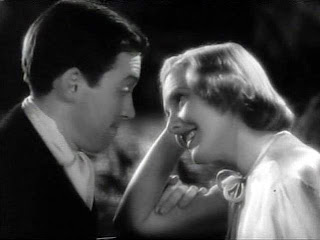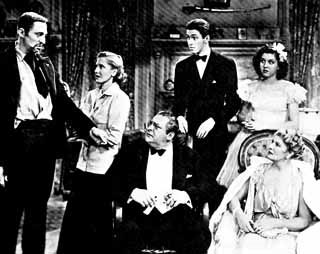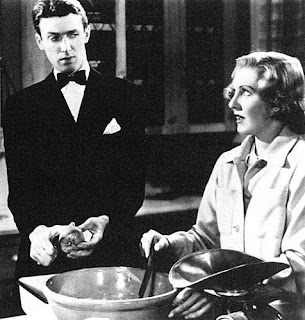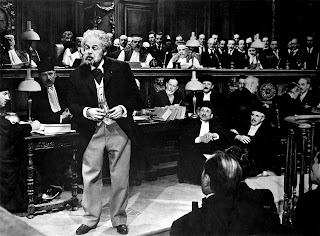"Maybe it'll stop you trying to be so desperate about making more money than you can ever use? You can't take it with you, Mr. Kirby. So what good is it? As near as I can see, the only thing you can take with you is the love of your friends." -Grandpa Vanderhof to Mr. Kirby in You Can't Take It With You
Always and forever will I be a big fan of Frank Capra. And while this one isn't my absolute favorite, Capra and Stewart still make a pretty incredible film. Even Lionel Barrymore, whose squeaky voice and quirky demeanor make him seem like the grandpa you've always wanted (as apposed to his turn as the evil Mr. Potter in
It's a Wonderful Life
which makes him seem like the grandpa who kills kittens). In any event, this film is a fun, Capracorn ride through small town America. It's not his best, but it's definitely worth a look.
The Plot
Mr. Anthony P. Kirby has everything he could want. He has a thriving banking business and a son, Tony, who is vice president and ready to follow in his footsteps. His latest business deal involves buying all the homes in a small town so he can build a plant. Only one house now evades him, and he sends his man, Mr. Blakely, to bully Martin Vanderhof into selling "by any means necessary."
Mr. Vanderhof, played by
Lionel Barrymore, known to all as "Grandpa," has no interest in selling. He once had a corporate job that brought him no joy, so he quit and went home to do the things that he loved. He became a stamp collector, and from that moment on encouraged all his family to do the same. His daughter, Penny Sycamore, writes plays, sculpts and paints. His son-in-law, Paul Sycamore, makes fireworks in the basement along with the iceman, Poppins, who came in one day and never left. His granddaughter Essie is a ballerina and makes candy, while her husband Ed plays the xylophone and sells her candy. Her ex-Russian dance instructor, Boris Kolenkhov, is a frequent visitor. Grandpa Vanderhof's most recent recruit is a teller at Mr. Kirby's bank who now helps out with the fireworks and makes his own masks and toys. No one is particularly good at what they do, but all that matters is that everyone is having fun and enjoying life.
 |
| Alice and Grandpa Vanderhof |
Alice Sycamore, Grandpa Vanderhof's other granddaughter, is the only remotely normal one of the bunch. Alice, played by
Jean Arthur, is Tony Kirby's secretary. Tony, played by
Jimmy Stewart, isn't very interested in a career in banking. He is far more interested in Alice, and despite his mother's disapproval proposes marriage. He meets her family when he picks her up for a date, and is drawn to their zany, fun-loving way of life. He watches Grandpa refuse to pay a tax collector, as he is convinced the government has no need for his money. Tony tells Alice he and a college classmate had been trying to invent a way to harness solar energy, but gave up their dreams to work stable jobs.
 |
| Alice Sycamore and Tony Kirby |
Try as she might, Alice continually fails to fit in with Tony's parents. Convinced that their marriage and families can fit, Tony has Alice invite his family over for dinner. But to stop her from making her family into something they're not, he deliberately brings his parents over on the wrong day. He finds the family in a more than usual state of craziness and the clash between the two families comes to a boil. Distraught, Alice asks Tony and his family to leave. Meanwhile, Blakely has been hard at work to corner Grandpa Vanderhof, and causes the police to raid the home in search of illegal fireworks and communist propaganda. They arrest everyone in the house but inadvertently set off all the fireworks, forcing everyone into the street.
 |
| Poppins poses for Penny while Essie dances for Boris |
Everyone is in jail, divided by the sexes. Mr. Kirby treats everyone as though they are beneath him, and berates his son for causing so many problems. Mrs. Kirby rebuffs all of Alice's attempts at a reconciliation. Grandpa finally confronts Mr. Kirby and loses his temper, telling him that all the money in the world won't make him happy without friends. He feels badly after, and offers his harmonica as a gift to make amends, knowing that Mr. Kirby was once a great harmonica player. Mr. Blakely weasels up to the jail and starts to threaten Grandpa before realizing that his actions have also jailed Mr. Kirby. He hurries to put it right by calling all of Mr. Kirby's lawyers.
 |
| The families at odds |
Finally, they are all called into night court, where the seats are filled with the entire town (all of Grandpa's friends.) The Vanderhofs are let off for disturbing the peace, but are charged $100 for making fireworks without a permit. Mr. Kirby (through his lawyers) offers to pay the fine as a charitable donation, but instead the townspeople rush forward to pay the fine together. Unless Mr. Kirby can explain why he was visiting the Vanderhofs, he will be charged with disturbing the peace. Mrs. Kirby refuses to admit that her son was considering marrying someone as lowly as Alice, and Grandpa finally has to save them by suggesting that Mr. Kirby was visiting to consider buying his house. Alice, however, marches up to Mrs. Kirby and proclaims the truth, adding that Mrs. Kirby need not worry, Alice would never marry into such snobs. Reporters burst through the door, and Alice runs away.
 |
| Alice tries desperately to impress the Kirbys |
Alice has gone to stay with an old friend to avoid the press, but cries herself to sleep every night. Tony is desperate to fine her, but her family refuses to tell. Grandpa Vanderhof decides to move to be close to her so Alice has her family and sells the house to Blakely. Mr. Kirby's deal goes through, and everyone in the town is evicted.
 |
| Tony brings his family to dinner on the wrong day. |
Mr. Kirby decides that his son will be in charge of the new deal, putting his friend Ramsey out of a job. But Tony refuses the job and quits, knowing that this job will never make him happy and still grieving over Alice. Ramsey dies of heart failure from the stress of losing his job. Mr. Kirby is left with only his job, now having lost his son and his friend. He rides the elevator up to the meeting, but lets the doors close again and rides down to the lobby. He walks over to visit the Vanderhofs.
 |
| Grandpa and Mr. Kirby reunite Tony and Alice |
The Vanderhofs are in the middle of moving, but Tony can't help but stop by. He pleads for Alice's address and while Grandpa refuses he does let Tony go upstairs, knowing Alice would soon stop by for her things. The two fight it out upstairs and suddenly Mr. Kirby appears downstairs. While Mr. Kirby is at a loss for what to do, Grandpa convinces him that if he just stops focusing on money and plays his harmonica, everything will turn out alright. He's skeptical at first, but agrees to play with Grandpa. The family and townspeople begin to dance and laugh. Alice and Tony, hearing the noise, come downstairs and see their families reconciled. Alice agrees to marry Tony and falls into his arms while Mrs. Kirby faints in the background. In the final scene, Mr. Kirby has sold back the Vanderhof house and the family is sitting down to dinner.
 |
| The entire family sits down to dinner. |
The History
Harry Cohen, the head of Columbia Studios, paid $200,000 for the rights to George S. Kaufman and Moss Hart's Pulitzer Prize-winning play,
You Can't Take It With You
, which was still enjoying a successful run on Broadway when Capra's film opened. Cohen didn't have much choice. Capra had sued him earlier in the year for trying to market Jean Arthur's latest film,
If You Could Only Cook
, as a Capra picture (though it wasn't) and part of the settlement included the proviso that Columbia both purchase the rights to the film and allow Capra to direct it. Cohen grumbled, but he should have remembered that Frank Capra had as much star power on a marquee as a famous actor. The movie was a hit with critics and audiences, and was the highest grossing film of the year. This would be the first paring of Jimmy Stewart and Frank Capra, as well as the first of several films with both Jean Arthur and Jimmy Stewart. During filming, Lionel Barrymore's arthritis was so bad he had to walk on crutches (which Capra worked into the film) and receive injections every hour.
Ann Miller, who was only 15 years old, had her first leading role as Essie, Alice's sister. But the point shoes she had to wear hurt her feet so badly that she would often run off between takes and cry where no one could see her. She never complained to the crew, but Jimmy Stewart noticed her tears and started sending boxes of candy to her room to make her feel better. The film would go on to win two out of its seven nominations: "Best Picture" and "Best Director." Today this film is notable as another Capra classic, though not perhaps as well known as
It Happened One Night 
or
It's a Wonderful Life
. But the combination of a star cast and Capra charm makes this film a solid classic that is still enjoyed today.
 |
| Capra at a screening for his film. |
As far as the Academy was concerned, however, Capra ironically almost managed to throw a wrench in his beloved ceremony. Having seen his success as the president of the Academy of Motion Pictures, the Director's Guild decided to elect him president as well. When
Joseph Schenck, head of the Association of Motion Picture Producers, refused to recognize the Directors Guild as representation for directors, Capra threatened to resign as president of the Academy, boycott the ceremony, and organize a directorial strike. The Awards had become too important to producers; the AMPP backed down and the ceremony went on as usual--with Capra winning his third Oscar to date.
 |
| Capra directing You Can't Take It With You |
The Academy refused to allow a radio broadcast of the event, but technician George Fisher hung an extra microphone with the PA system he had set up earlier and broadcast the Awards until Academy and Biltmore officials started to smash in his booth with axes in order to catch him. Special awards were handed out to
Mickey Rooney and
Deanna Durbin as the year's two most profitable young actors, and to Walt Disney for his production of
Snow White and the Seven Dwarfs
. Disney's Oscar was a little different, it included one large Oscar and seven smaller statues. And though Hollywood was beginning to question the validity of winning multiple Oscars,
Spencer Tracey had no such concern. He was only concerned with the fact that his name was spelled "Dick Tracey" on his second Oscar (for his turn as Father Flanagan in the film
Boys Town). He sent the statue back to be redone, and some enterprising publicist spread rumors that he was having it engraved for the real life Father Flanagan, the founder of Boys Town, a center for underprivileged young men. Never a philanthropist, Tracey insisted that he then receive two statues, one for Flanagan and one for himself. Even though the Academy capitulated, the next year's Awards ceremony would be the last he would attend.
 |
| Shirley Temple presents Walt Disney with his Special Oscar. |
The Verdict?
This movie is best absorbed in parts, because as a whole you need to pause the movie several times to sort out your confusion. An overabundance of characters and a desire to get as many moral messages out to the public as possible without real regard to the plot bogs down the film. Just because something is funny or cute, doesn't mean it adds to the story. The slower parts of the movie are made better by some truly bright spots, most of them including Jimmy Stewart. He is so engaging that every moment he spends with Jean Arthur just makes me fall in love with him a little more. Their scenes are by far the best part of the film, at least for me. Come on, he bought Ann Miller chocolates! How can you not fall in love? Lionel Barrymore I can appreciate, but his role seems little more than an opportunity for Frank Capra to voice his views on the evils of big-city America. Which brings me to...
The Anatomy of a Capra Film
As this is my last Oscar-winning Capra film, it's probably a good time to describe the basic structure of most Capra films. This does not include It Happened One Night, but from the mid-thirties to the mid-forties, almost all of his films follow this basic pattern.
Capra takes your humble good-guy hero and plunks him in good 'ole small-town America. He usually has a loving family, or family substitute, and a town filled with supportive, fun-loving characters. Capra's big on individualism, so every one of this characters has his own story, his own flaws, and his own unique traits (giving rise to some incredible scene-stealing performances by Capra's character actors). No one is too rich or too poor, and every is happy just going about their business. As the villain, Capra throws in a money-loving, heartless capitalist who views common people as peons to be stomped on his way to more money and glory. Now take our hero and make him clash with the villain. Let him be beaten down by corporate America, perhaps disillusioned by what he thought he wanted. And then, right as we believe all his small town values have failed him, Capra will let all the family/townsfolk march in and prove that with a little love and a lot of friends anything is possible. Take that, Goliath.
You Can't Take It With You is no different. It follows the same pattern, but I can't completely love it because it utterly fails in comparison to It's a Wonderful Life. When the townspeople save Grandpa in the end, it feel comical rather than sincere. And Grandpa's moralizing sermons on the dangers of living your life by rote lose their force because he repeats himself so many time. It feels as though Capra has not evolved yet, and as this film is eight years before It's a Wonderful Life, he probably has not. But I can find a place in my heart for this movie, as I can for any film by Frank Capra. The Associated Press review of You Can't Take It With You encapsulates my feelings exactly: "You'll leave the movie house thinking it's pretty nice they have such things as movies, because movies have made you feel so very good."































